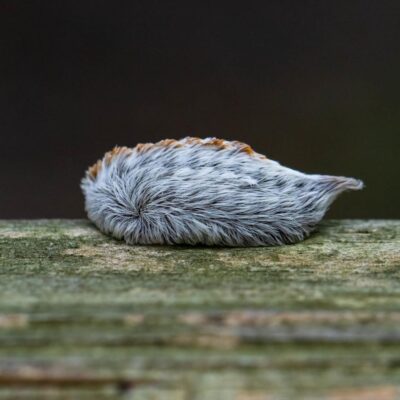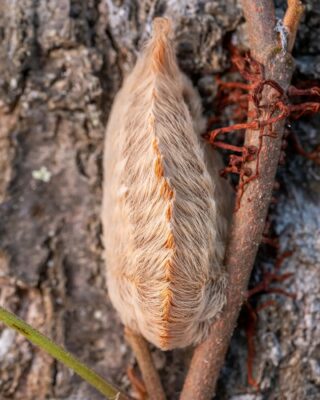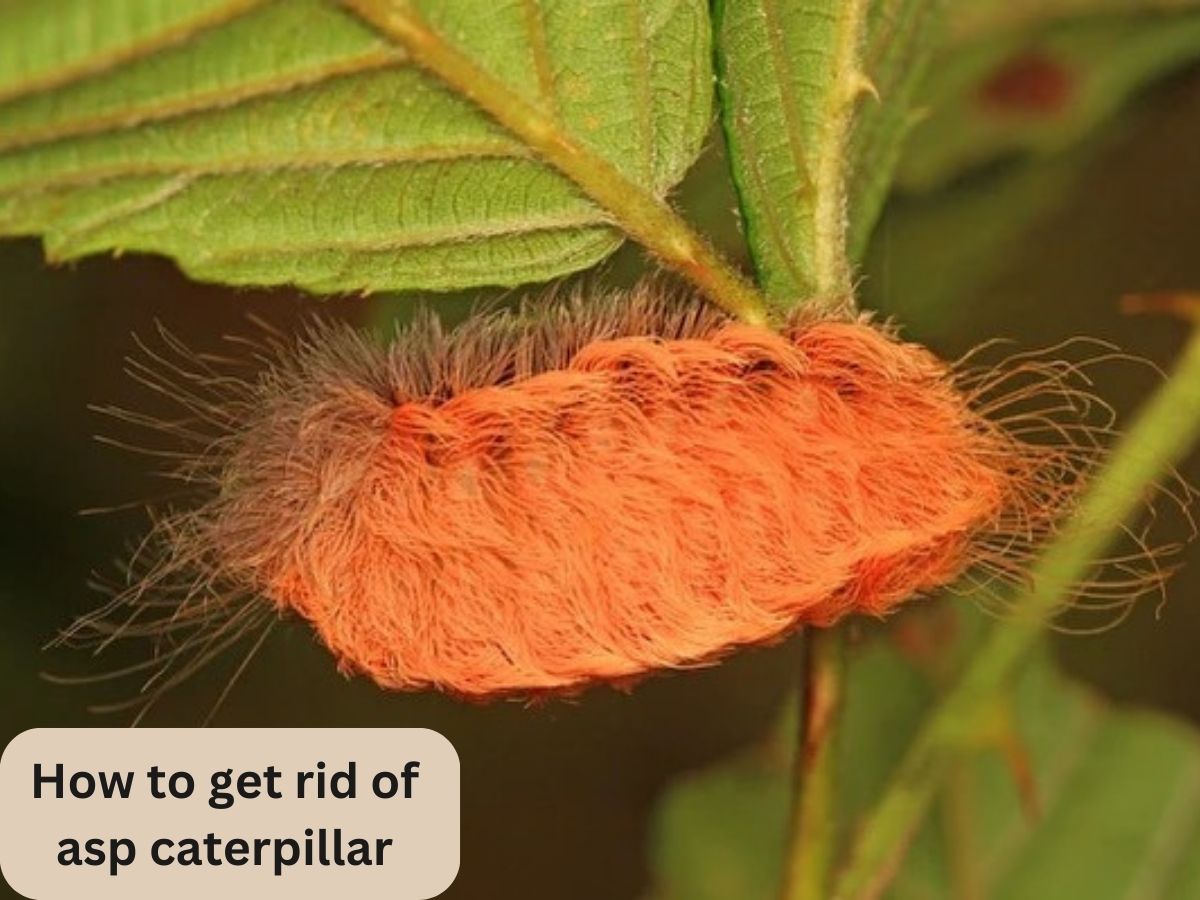Ready to take your garden back from those sneaky troublemakers? Discovering how to get rid of asp caterpillars is your secret weapon for maintaining a peaceful and thriving outdoor haven. These seemingly harmless critters can pack a punch with their venomous spines, leaving you and your plants in discomfort.
But fear not! In this guide, we’re delving into the art of bidding farewell to these fuzzy foes. Whether you’re a seasoned gardener or just starting, we’ve got the expert-backed tips and tricks you need to evict asp caterpillars from your green space.
From identifying these cunning caterpillars to unleashing natural predators and exploring targeted solutions, we’re here to help you navigate the battle against these garden invaders. So, if you’re ready to reclaim your garden with confidence, let’s dive into the world of how to get rid of asp caterpillars and regain your outdoor sanctuary.
Identification of Asp Caterpillar
Meet the master of disguise in the insect world: the asp caterpillar. This tiny troublemaker may look innocent at first glance, but don’t let its appearance fool you. The asp caterpillar boasts a color palette that ranges from shades of brown to black, making it blend seamlessly into its surroundings.
Sizing up at just half an inch to an inch long, it might resemble a miniaturized toupee or a soft, furry tuft. However, beneath that cuddly exterior are venomous spines ready to deliver a nasty sting. It’s essential to be able to identify these cunning critters to take the right action and protect your garden oasis. So, keep your eyes peeled for these deceptive crawlers with a knack for hiding in plain sight.
Safety Precautions
When it comes to dealing with these deceptive caterpillars, safety should be your top priority. Imagine encountering a seemingly harmless tuft of fur that can deliver a sting like no other. To avoid this prickly situation, arm yourself with gloves and protective clothing before attempting any hands-on removal.
Why the extra precautions? Well, those innocent-looking spines come with a not-so-innocent payload. The asp caterpillar’s venomous spines can trigger allergic reactions and lead to skin irritation that you won’t soon forget.
So, whether you’re facing a caterpillar invasion head-on or simply exploring your garden, suiting up in your garden warrior gear is a smart move. Protection not only gives you peace of mind but also keeps those pesky spines at bay. Stay safe and shielded as you take on these furry foes.
How to Get Rid of Asp Caterpillar: Effective Methods
Dealing with asp caterpillars requires a multi-pronged approach to ensure they’re banished from your garden. Let’s delve into the details of three powerful methods: manual removal, deterrent sprays, and the use of horticultural oils and insecticidal soaps.

Manual Removal:
Manual removal might sound straightforward, but it’s a hands-on strategy that can yield significant results. Here’s how to go about it:
- Gather Your Supplies: First, equip yourself with a pair of sturdy gloves. These will shield your hands from the caterpillar’s venomous spines.
- Scout for Caterpillars: Carefully inspect the plants in your garden, looking for asp caterpillars. They might be hiding on the underside of leaves, stems, or even in plant crevices.
- Remove with Caution: Once you locate a caterpillar, gently pluck it off the plant using your gloved hand. Place the caterpillar in a container with a lid for safe disposal.
- Repeat the Process: Continue this process throughout your garden, paying special attention to areas where caterpillars are most abundant.
Deterrent Sprays:
Deterrent sprays offer a non-toxic method to discourage asp caterpillars from feasting on your plants. Here’s how to create and use one:
- Prepare the Spray: In a spray bottle, mix a solution of mild dish soap, neem oil, and water. The soap acts as a deterrent without causing harm to your plants.
- Shake and Spray: Thoroughly mix the solution by shaking the bottle. Then, generously spray the affected plants, targeting both the upper and lower leaf surfaces.
- Repeat as Needed: Reapply the spray every few days or after rainfall, ensuring that the caterpillars encounter the deterrent whenever they return.
Horticultural Oils and Insecticidal Soaps:
Horticultural oils and insecticidal soaps provide a gentle yet effective solution to eliminate asp caterpillars. Here’s how to use them:
- Choose Your Product: Purchase a horticultural oil or insecticidal soap from your local garden center. Ensure it’s safe for the specific plants you want to treat.
- Mix and Apply: Follow the manufacturer’s instructions to mix the solution. Once prepared, spray it onto the caterpillar-infested plants, covering them thoroughly.
- Target Larvae: These products can also be effective against caterpillar eggs and larvae. Make sure to target the areas where you suspect eggs may be present.
- Use with Caution: While horticultural oils and insecticidal soaps are generally safe for plants, avoid spraying during the hottest part of the day to prevent plant stress.
By employing these methods, you can effectively tackle asp caterpillar infestations and reclaim your garden from their mischief. Remember to combine these strategies for optimal results and keep a watchful eye on your plants to maintain a caterpillar-free environment.
Biological Controls:
Nature has its pest management system, and you can tap into it by encouraging natural predators. Here’s how to make nature work for you:
- Attract Beneficial Birds: Create an inviting environment for birds by setting up bird feeders and bird baths. Birds like sparrows, chickadees, and wrens are natural predators of caterpillars and can help control their population.
- Invite Parasitic Wasps: These tiny wasps lay their eggs on caterpillars, ultimately leading to their demise. Plant nectar-rich flowers like daisies and fennel to attract these helpful wasps.
- Avoid Chemicals: To maintain a healthy population of natural predators, avoid using broad-spectrum pesticides that could harm beneficial insects.
Neem Oil:
Neem oil is a natural insecticide derived from the neem tree. It disrupts the caterpillar’s growth and development, making it a powerful tool in your arsenal:
- Choose a Quality Product: Purchase neem oil from a reputable source or garden center. Ensure it’s labeled for caterpillar control and suitable for the plants you intend to treat.
- Prepare the Solution: Mix the neem oil according to the manufacturer’s instructions. Neem oil may solidify at cooler temperatures, so warm it up slightly if needed.
- Apply to Infested Areas: Using a sprayer, apply the neem oil solution to the affected plants, targeting the areas where caterpillars are present.
- Repeat as Necessary: Neem oil has a residual effect, but multiple applications might be necessary to effectively manage the caterpillar population.

Pruning:
Pruning isn’t just about maintaining the aesthetic appeal of your garden – it can also help control caterpillar populations:
- Identify Infested Parts: Regularly inspect your plants for signs of caterpillar activity. If you spot chewed leaves or clusters of eggs, these are prime candidates for pruning.
- Use Sharp Tools: Employ sharp and clean gardening tools to carefully remove infested branches and leaves. Dispose of these materials in a sealed bag to prevent caterpillars from spreading.
- Promote Plant Health: Pruning not only removes caterpillars but also enhances the overall health of your plants by eliminating diseased or damaged parts.
Sticky Traps:
Sticky traps provide a clever way to catch caterpillars in their tracks, effectively reducing their numbers:
- Set Up the Traps: Place sticky traps near your plants, focusing on areas where caterpillar activity is evident. The traps will attract and catch the wandering caterpillars.
- Strategic Placement: Position the traps at various heights to target both ground-crawling and tree-climbing caterpillars.
- Monitor and Replace: Regularly check the traps for captured caterpillars. Replace the traps as needed to ensure their effectiveness.
Regular Inspections:
Staying vigilant with routine inspections is key to early detection and prevention of asp caterpillar infestations:
- Establish a Routine: Set a schedule for inspecting your plants, aiming for at least once a week. Be thorough and check both sides of leaves, stems, and any potential hiding spots.
- Look for Signs: Keep an eye out for chewed leaves, clusters of eggs, or the caterpillars themselves. Catching the problem early makes management much easier.
- Take Prompt Action: If you spot any signs of caterpillar presence, employ your chosen removal or control method immediately.
Introduce Beneficial Nematodes:
Beneficial nematodes are microscopic organisms that can lend a hand in reducing caterpillar populations:
- Select the Right Nematodes: Purchase nematodes specifically designed to target caterpillars. These beneficial organisms invade caterpillar larvae and help control their numbers.
- Apply as Directed: Mix the nematodes with water according to the package instructions. Apply the solution to the soil in affected areas.
- Timing Matters: Apply nematodes during the caterpillar larvae’s active season for the best results.
By incorporating sticky traps, committing to regular inspections, and harnessing the power of beneficial nematodes, you’re further enhancing your arsenal in the fight against asp caterpillars. Keep experimenting with different methods to find the most effective combination for your garden’s unique needs. Remember, persistence pays off, and your efforts will help create a caterpillar-free sanctuary.
Chemical Insecticides
Certainly, here are three effective chemical insecticides that can help you get rid of asp caterpillars, along with explanations of how they work:
Bt (Bacillus thuringiensis):
Bt is a biological insecticide that targets specific caterpillar larvae, including asp caterpillars. It contains bacteria that produce toxins harmful to caterpillars but generally safe for humans, pets, and beneficial insects.

How it works:
- When caterpillars consume plant material treated with Bt, the bacteria’s toxins disrupt their digestive systems, causing them to stop feeding.
- Within a few days, the caterpillars die as a result of starvation.
Advantages:
- Highly targeted, affecting only caterpillars.
- Low risk to non-target organisms and the environment.
- Can be used on edible plants.
- Doesn’t harm beneficial insects.
Spinosad-based Insecticides:
Spinosad is derived from a soil bacterium and acts as a nerve toxin when ingested by caterpillars.

How it works:
- When caterpillars ingest or come into contact with spinosad, it affects their nervous system, leading to paralysis and death.
- Spinosad-based products have contact and stomach activity, providing effective control.
Advantages:
- Fast-acting against caterpillars.
- Effective against a wide range of caterpillar pests.
- Has a relatively low impact on non-target insects, such as bees and beneficial insects, when used as directed.
Pyrethroid Insecticides:
Pyrethroids are synthetic chemicals modeled after natural pyrethrins, which are derived from chrysanthemum flowers.

How it works:
- Pyrethroids disrupt the nervous system of insects, including caterpillars, causing paralysis and death.
- They have contact and residual activity, providing ongoing protection.
Advantages:
- Quick knockdown effect on caterpillars.
- Wide availability in various formulations (sprays, dusts, etc.).
- Can offer both contact and residual control.
Important Considerations:
- While these chemical insecticides can be effective against asp caterpillars, they should be used judiciously and as a last resort.
- Always read and follow the label instructions carefully to ensure proper application and safety.
- Be cautious when using these products in areas frequented by children, pets, and beneficial insects.
- Consider using non-chemical methods and integrated pest management (IPM) strategies whenever possible to minimize environmental impact.
Remember, before using any chemical insecticide, it’s important to assess the severity of the infestation, and the potential impact on non-target organisms, and to follow the recommended application rates and safety precautions.
Preventing Asp Caterpillar Infestations: Your Shield of Defense
When it comes to dealing with asp caterpillars, an ounce of prevention is worth a pound of cure. Let’s explore preventive measures that can help you create a fortress against these pesky critters:
- Regular Inspections: Make a habit of inspecting your plants at least once a week. By catching early signs of caterpillar activity – like chewed leaves, eggs, or wandering caterpillars – you can swiftly intervene before the infestation spirals out of control.
- Maintain a Clean Garden: A tidy garden is less inviting to unwanted visitors. Regularly remove fallen leaves, debris, and decaying plant matter, as these can serve as breeding grounds for caterpillars and other pests.
- Encourage Natural Predators: Invite beneficial creatures to your garden that naturally prey on caterpillars. Birds like sparrows and chickadees, as well as parasitic wasps, can help keep caterpillar populations in check. Attract them with bird feeders, bird baths, and nectar-rich flowers.
- Choose Resistant Plants: Opt for plant varieties that asp caterpillars tend to avoid. Research plants that are less appealing to these critters and incorporate them into your garden design.
- Physical Barriers: If your plants are particularly vulnerable, consider using physical barriers like row covers or mesh to prevent caterpillars from gaining access.
- Pruning and Trimming: Regularly prune and trim your plants to remove any parts that might be harboring caterpillar eggs or larvae. This not only prevents infestations but also promotes the overall health of your garden.
- Nematodes as Allies: Beneficial nematodes, microscopic worms that attack caterpillar larvae, can be introduced to your soil to naturally control caterpillar populations.
- Healthy Soil and Plants: Strong, healthy plants are better equipped to resist pest attacks. Maintain proper soil nutrition, watering, and overall plant care to boost their natural defenses.
- Companion Planting: Strategically plant herbs and flowers like mint, rosemary, and marigold around susceptible plants. These can act as natural repellents and discourage caterpillars.
- Rotate Crops: If you have a vegetable garden, practice crop rotation to disrupt the life cycle of pests, including caterpillars.
By adopting these preventive measures, you’ll be fortifying your garden against asp caterpillar infestations, ensuring that your outdoor space remains a sanctuary of beauty and tranquility. Remember, a proactive approach can save you time, effort, and frustration in the long run.

How to Get Rid of asp Caterpillars FAQs?
Can the venomous spines of the caterpillar cause serious health issues?
Absolutely. While the asp caterpillar might seem harmless, its venomous spines are no joke. Contact with these spines can lead to intense pain, skin irritation, redness, swelling, and even allergic reactions in some individuals.
It’s crucial to handle these caterpillars with care, wearing gloves and protective clothing to avoid direct skin contact. If you experience severe symptoms after encountering an asp caterpillar, seek medical attention promptly.
Are there any natural predators that can help control the caterpillar population?
Yes, nature provides some allies in the battle against caterpillar infestations. Birds like sparrows, chickadees, and wrens are natural caterpillar hunters. Creating a bird-friendly environment with feeders and bird baths can encourage these feathered friends to visit your garden.
Additionally, parasitic wasps lay their eggs on caterpillars, leading to their demise. Planting nectar-rich flowers can attract these beneficial wasps. Attracting and sustaining these natural predators can help naturally keep caterpillar populations in check.
What precautions should I take when using chemical insecticides?
When considering chemical insecticides, it’s essential to prioritize safety for yourself, your family, pets, beneficial insects, and the environment. Here are some key precautions to keep in mind:
- Read and follow the label instructions meticulously to ensure proper application.
- Wear appropriate protective clothing, including gloves, goggles, and long sleeves.
- Apply insecticides during calm weather to prevent drift and unintended exposure.
- Use chemical insecticides sparingly and only when other methods have proven ineffective.
- Be cautious when using these products in areas frequented by children, pets, and beneficial insects.
- Dispose of any leftover products and containers responsibly, following local disposal guidelines.
How often should I inspect my garden for caterpillar presence?
Regular garden inspections are essential to catch caterpillar infestations early. We recommend conducting inspections at least once a week, especially during the warmer months when caterpillar activity is at its peak.
Check both sides of leaves, stems, and areas where caterpillars might hide. Look for chewed leaves, clusters of eggs, and actual caterpillars. Prompt detection allows you to take swift action, preventing an infestation from gaining momentum and causing more damage to your plants.
Conclusion
As you wrap up your journey through the world of asp caterpillars, you’ve gained a comprehensive understanding of how to safeguard your garden and outdoor space. Armed with a diverse array of methods – from natural remedies to targeted interventions – you’re well-equipped to bid farewell to these fuzzy troublemakers.
By identifying the telltale signs of infestations, practicing regular inspections, and tapping into the power of nature’s allies, you’re not just eradicating caterpillars; you’re creating a harmonious ecosystem where your plants can flourish without fear of marauding caterpillars.
Remember, each method has its strengths, and finding the right combination that aligns with your garden’s needs is key. From manual removal to employing biological controls, chemical interventions, and preventive measures, your garden’s defense strategy is as unique as your green sanctuary itself.
So go forth with confidence, armed with knowledge and a determined spirit. Your garden – once besieged by asp caterpillars – is now a sanctuary of beauty, tranquility, and life. Embrace your newfound expertise, take action, and revel in the caterpillar-free haven you’ve nurtured. Here’s to a thriving, pest-free garden that reflects the harmony and balance of nature itself.
